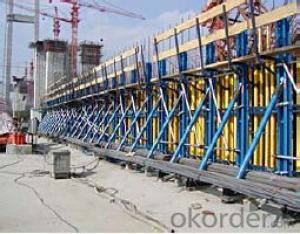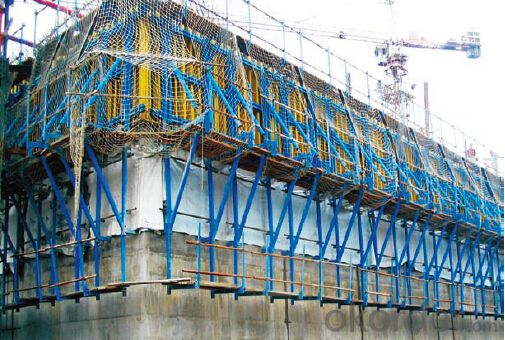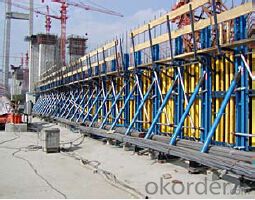Single-Side Climbing Bracket for formwork and scaffolding system
- Loading Port:
- Tianjin
- Payment Terms:
- TT OR LC
- Min Order Qty:
- 50 m²
- Supply Capability:
- 1000 m²/month
OKorder Service Pledge
OKorder Financial Service
You Might Also Like
Single-side Climbing Bracket SCB180:
With CNBM SCB 180 climbing systems, the loads from the fresh concrete pressure are
transferred through the brackets by means of V-strongbacks and compression braces into the
scaffold anchors.
Typical applications for the SCB 180 are dams, locks, cooling towers, pier heads, tunnels, and
bank vaults.
The formwork is simply tilted backwards when striking takes place. The 1.80 m wide bracket
requires only a minimum of space.
Characteristics:
◆ Economical and safe anchoring
The M30/D20 climbing cones have been designed especially for single-sided concreting using
SCB180 in dam construction, and to allow the transfer of high tensile and shear forces into the still
fresh, unreinforced concrete. Without wall-through tie-rods, finished concrete is perfect.
◆ Stable and cost-effective for high loads
generous bracket spacings allow large-area formwork units with optimal utilization of the bearing
capacity. This leads to extremely economical solutions.
◆ Simple and flexible planning
With SCB180 single-sided climbing formwork, circular structures can also be concreted without
undergoing any large planning process. Even use on inclined walls is feasible without any special
measures because additional concrete loads or lifting forces can be safely transferred into the
structure.
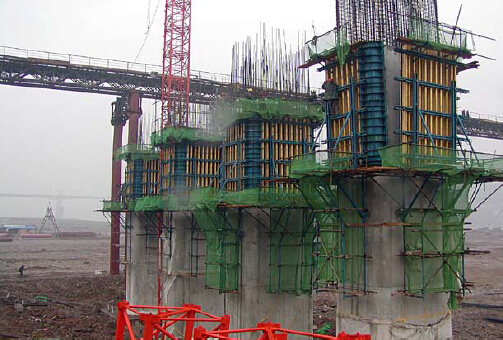
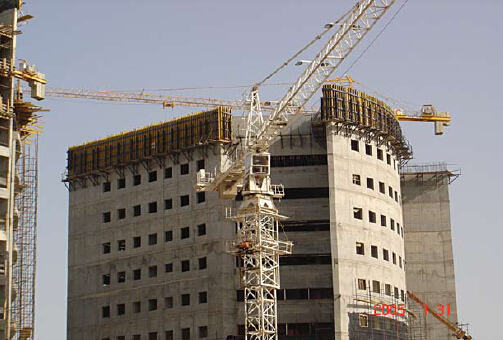
- Q: What materials are used in steel formwork construction?
- Steel formwork construction primarily involves the use of steel sheets, beams, angles, channels, brackets, and fasteners, such as bolts and screws.
- Q: What are the different types of formwork corners used in steel formwork systems?
- In steel formwork systems, there are several types of formwork corners used to create different shapes and angles in the construction process. These corners are designed to provide stability, support, and flexibility in forming concrete structures. Some common types of formwork corners used in steel formwork systems are: 1. External 90-Degree Corner: This type of corner is used to create a right angle or 90-degree corner in the formwork. It is typically made of steel plates and angles that are connected and reinforced to provide strength and stability. External 90-degree corners are commonly used in building walls, columns, and beams. 2. Internal 90-Degree Corner: Similar to the external 90-degree corner, the internal 90-degree corner is used to create a right angle or 90-degree corner in the formwork. However, it is designed to be placed inside the formwork, providing a smooth finish on the exposed concrete surface. Internal 90-degree corners are commonly used in walls, columns, and other structures where a clean finish is desired. 3. Adjustable Corner: An adjustable corner is used when there is a need for different angles and shapes in the formwork. It consists of adjustable steel plates and angles that can be positioned and locked into place to create the desired shape and angle. Adjustable corners are versatile and can be used for various applications such as curved walls, sloping structures, and irregular shapes. 4. Chamfered Corner: A chamfered corner is used to create a beveled or chamfered edge on the concrete structure. It is typically made of steel plates and angles that are positioned to form a specific angle or bevel. Chamfered corners are commonly used in architectural applications to create decorative edges, enhance the appearance of the structure, and provide a smooth transition between different elements. 5. Rounded Corner: A rounded corner is used to create a curved or rounded edge in the concrete structure. It is typically made of steel plates and angles that are bent or shaped to form the desired curve or radius. Rounded corners are commonly used in architectural applications, such as curved walls, arches, and other curved elements, to create a visually appealing and unique design. These are just a few examples of the different types of formwork corners used in steel formwork systems. The specific type of corner used will depend on the desired shape, angle, and finish of the concrete structure being formed. It is important to select the appropriate formwork corner to ensure the integrity and quality of the construction project.
- Q: How does steel formwork contribute to the overall constructability of the project?
- Steel formwork plays a crucial role in construction projects, contributing significantly to the overall constructability. Its importance can be seen in various aspects of the construction process. To begin with, the strength and durability of steel formwork allow it to withstand the pressure exerted by concrete during pouring. This strength ensures that the formwork remains intact, enabling the construction of structures with complex shapes and designs. It also allows for the use of thicker and heavier concrete, resulting in stronger and more durable structures. Furthermore, steel formwork provides accuracy and precision in shaping concrete structures. Its rigid structure and dimensional stability allow for consistent and uniform concrete placement, ensuring that the final product meets the desired specifications. This accuracy is crucial for achieving the desired aesthetic and functional outcome of the project. In addition, steel formwork offers versatility and adaptability. It can be easily modified, adjusted, and reused for different projects, making it a cost-effective option. This flexibility is particularly useful when changes or modifications need to be made during the construction process. The ability to quickly adapt the formwork saves time, reduces material wastage, and enhances overall project efficiency. Moreover, steel formwork improves construction speed. Its strength and stability allow for faster concrete pouring and setting times. This expedited construction process reduces project timelines, resulting in cost savings and increased productivity. Another important contribution of steel formwork is its enhanced safety features. It is designed with safety in mind, incorporating handrails, access platforms, and non-slip surfaces. These features provide a safe working environment for construction workers, reducing the risk of accidents and injuries. In conclusion, steel formwork significantly contributes to the overall constructability of a project through its strength, accuracy, versatility, speed, and safety features. Its ability to withstand extreme loads, provide precise shaping, adapt to changes, expedite construction, and enhance safety make it an invaluable component in construction projects.
- Q: How does steel formwork handle concrete curing additives?
- Steel formwork is a popular choice for concrete construction due to its durability and strength. When it comes to handling concrete curing additives, steel formwork is highly compatible and can effectively accommodate the use of such additives. Concrete curing additives, such as accelerators or retarders, are used to modify the setting and hardening time of concrete. These additives are typically added to the concrete mixture during the mixing process or applied to the surface of the formwork before pouring the concrete. Steel formwork is not adversely affected by the presence of curing additives in the concrete. It is resistant to chemical reactions and can withstand the potentially corrosive nature of certain additives. This ensures that the steel formwork remains structurally sound and maintains its integrity throughout the concrete curing process. Furthermore, steel formwork offers a smooth and non-porous surface, which allows for easy application and penetration of curing additives. This facilitates the even distribution of additives across the concrete surface, promoting consistent curing and optimal strength development. Moreover, steel formwork is reusable, which means that it can be used for multiple concrete pours. This reusability factor is particularly advantageous when working with concrete curing additives, as the formwork can be easily cleaned after each use, ensuring that no residue or build-up of additives remains on the surface. This helps to prevent any potential interference with subsequent concrete pours or compromising the quality of the cured concrete. In summary, steel formwork is well-suited for handling concrete curing additives. Its chemical resistance, smooth surface, and reusability make it an ideal choice for accommodating the use of curing additives, ensuring efficient and effective concrete curing.
- Q: Can steel formwork be used for both vertical and horizontal structures?
- Indeed, steel formwork proves to be a viable option for both vertical and horizontal structures. This construction material showcases its versatility and durability, allowing it to be molded and shaped according to the specific requirements of different structural elements. Whether it be walls, columns, beams, slabs, or any other structural component, steel formwork can be utilized in both vertical and horizontal orientations. The robustness and firmness of steel make it capable of withstanding the considerable pressure exerted by concrete during the casting process, ensuring that the formwork maintains its shape and stability. Furthermore, steel formwork offers the advantage of reusability, as it can be easily dismantled and reassembled. This quality makes it a cost-effective and efficient choice for construction projects involving both vertical and horizontal structures.
- Q: Can steel formwork be used for structures with complex geometries?
- Yes, steel formwork can be used for structures with complex geometries. Steel formwork is versatile and can be easily customized and adjusted to fit various shapes and sizes, making it suitable for constructing structures with intricate and complex designs. Its strength and durability also make it ideal for supporting and shaping concrete in challenging geometries.
- Q: What are the different types of formwork anchors used in steel formwork?
- There are several types of formwork anchors commonly used in steel formwork, including wedge anchors, sleeve anchors, and through-bolt anchors. Wedge anchors are inserted into pre-drilled holes in the steel formwork and are tightened with a wrench to secure the formwork in place. Sleeve anchors are similar to wedge anchors but have a sleeve that expands against the sides of the hole to provide additional stability. Through-bolt anchors consist of a threaded rod that passes through the formwork and is secured with a nut on the opposite side. These anchors offer a strong and reliable connection for steel formwork.
- Q: How does steel formwork prevent concrete spillage?
- Steel formwork prevents concrete spillage by providing a strong and rigid framework that contains and holds the concrete in place during the pouring and curing processes. The steel formwork is designed to have tight joints and a smooth surface, ensuring that no gaps or leaks are present for the concrete to escape through. This prevents any potential spillage or leakage of the concrete during the pouring process. Additionally, steel formwork is often reinforced with internal bracing or supports, which further enhances its strength and stability. This reinforcement helps to prevent any movement or deformation of the formwork, ensuring that it remains in its intended shape and position. By maintaining the formwork's integrity, the steel structure acts as a barrier, preventing the concrete from spilling or overflowing. Furthermore, steel formwork is typically built with vertical sides and bottom plates that are securely connected. This configuration creates a containment system that effectively holds the concrete in place, preventing it from flowing out or seeping through any gaps. The tight fit of the formwork also helps to achieve the desired shape and dimensions of the concrete structure being cast. Overall, steel formwork is a reliable and robust solution for preventing concrete spillage. Its strength, rigidity, and tight joints ensure that the concrete remains contained within the desired area, minimizing the risk of any spillage or leakage during the construction process.
- Q: What are the factors to consider when selecting steel formwork?
- To choose the right steel formwork, one must take into account various factors. Firstly, the strength and durability of the formwork are crucial. It should be able to bear the weight of the concrete and withstand the forces applied during pouring and curing. Additionally, it should maintain its structural integrity after multiple uses. Secondly, flexibility and adaptability are important considerations. The formwork should be easily adjustable and capable of accommodating different shapes and sizes of concrete elements. This is especially vital for complex or irregular structures. Next, the ease of assembly and dismantling plays a significant role. The formwork system should be quick and straightforward to put together and take apart, as this affects the overall construction timeline. The use of standardized components and a simple connection system can expedite this process. Furthermore, the surface finish of the concrete is a key factor, particularly for architectural projects. The steel formwork should provide a smooth and flawless surface without any visible marks or imperfections, ensuring a high-quality end result. Considering cost-effectiveness is also essential. The total cost of the formwork system, including the initial investment, maintenance, and reusability, should be taken into account. Although steel formwork may have a higher upfront cost, its durability and reusability make it a cost-effective choice in the long run. Safety is of paramount importance. The design and manufacture of the steel formwork should incorporate safety features such as non-slip surfaces, secure connections, and sufficient bracing to prevent accidents or collapses. Additionally, the environmental impact of the formwork material should be considered. Steel formwork is often considered more environmentally friendly than traditional timber formwork due to its ability to be reused and recycled. By considering these factors, construction professionals can make an informed decision when selecting steel formwork that meets their project requirements and delivers optimal results.
- Q: How does steel formwork affect the overall safety of a building project?
- Enhancing the overall safety of a building project is a crucial role that steel formwork plays. Its high strength and durability ensure a stable structure, preventing accidents such as collapses or structural failures that can cause serious injuries or fatalities. Furthermore, steel formwork offers a secure and dependable platform for workers. Its rigid structure minimizes the risks of slips, trips, and falls, which are common causes of accidents on construction sites. Additionally, safety features like handrails, guardrails, and non-slip surfaces can be incorporated into steel formwork designs, further enhancing worker safety. Another significant advantage of steel formwork is its fire-resistant properties. Unlike combustible materials, steel does not contribute to the spread of fire. This characteristic significantly reduces the potential for fire-related accidents, safeguarding both the workers and the structure itself. Moreover, steel formwork exhibits high resistance to adverse weather conditions, such as heavy winds, rain, or earthquakes. This resistance ensures the structure remains stable and secure even during extreme weather events, minimizing the risks of accidents or damage caused by these external factors. Lastly, steel formwork provides better quality control compared to other formwork materials. Its precise and consistent dimensions reduce the chances of errors or inconsistencies in the construction process, resulting in a safer and more reliable end product. In conclusion, steel formwork positively impacts the overall safety of a building project by providing stability, a secure working platform, fire resistance, weather resistance, and improved quality control. These factors collectively contribute to reducing the risks of accidents, injuries, and structural failures, making steel formwork an essential component in ensuring a safe construction environment.
Send your message to us
Single-Side Climbing Bracket for formwork and scaffolding system
- Loading Port:
- Tianjin
- Payment Terms:
- TT OR LC
- Min Order Qty:
- 50 m²
- Supply Capability:
- 1000 m²/month
OKorder Service Pledge
OKorder Financial Service
Similar products
Hot products
Hot Searches

